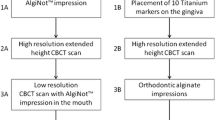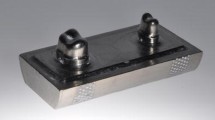Abstract
Objectives
Software-based dental planning requires digital casts and oftentimes cone-beam computed tomography (CBCT) radiography. However, buying a dedicated model digitizing device can be expensive and might not be required. The present study aimed to assess whether digital models derived from CBCT and models digitized using a dedicated optical device are of comparable accuracy.
Material and methods
A total of 20 plaster casts were digitized with eight CBCT and five optical model digitizers. Corresponding models were superimposed using six control points and subsequent iterative closest point matching. Median distances were calculated among all registered models. Data were pooled per scanner and model. Boxplots were generated, and the paired t test, a Friedman test, and a post-hoc Nemenyi test were employed for statistical comparison. Results were found significant at p < 0.05.
Results
All CBCT devices allowed the digitization of plaster casts, but failed to reach the accuracy of the dedicated model digitizers (p < 0.001). Median distances between CBCT and optically digitized casts were 0.064 + − 0.005 mm. Qualitative differences among the CBCT systems were detected (χ 2 = 78.07, p < 0.001), and one CBCT providing a special plaster cast digitization mode was found superior to the competitors (p < 0.05).
Conclusion
CBCT systems failed to reach the accuracy from optical digitizers, but within the limits of the study, accuracy appeared to be sufficient for digital planning and forensic purposes.
Clinical relevance
Most CBCT systems enabled digitization of plaster casts, and accuracy was found sufficient for digital planning and storage purposes.




Similar content being viewed by others
References
De Luca Canto G, Pacheco-Pereira C, Lagravere MO, Flores-Mir C, Major PW (2015) Intra-arch dimensional measurement validity of laser-scanned digital dental models compared with the original plaster models: a systematic review. Orthod Craniofac Res 18(2):65–76. https://doi.org/10.1111/ocr.12068
Abizadeh N, Moles DR, O'Neill J, Noar JH (2012) Digital versus plaster study models: how accurate and reproducible are they? J Orthod 39(3):151–159. https://doi.org/10.1179/1465312512z.00000000023
McGuinness NJ, Stephens CD (1992) Storage of orthodontic study models in hospital units in the U.K. Br J Orthod 19(3):227–232. https://doi.org/10.1179/bjo.19.3.227
Gonzalez de Villaumbrosia P, Martinez-Rus F, Garcia-Orejas A, Salido MP, Pradies G (2016) In vitro comparison of the accuracy (trueness and precision) of six extraoral dental scanners with different scanning technologies. J Prosthet Dent 116:543–550.e1. https://doi.org/10.1016/j.prosdent.2016.01.025
Mandelli F, Gherlone E, Gastaldi G, Ferrari M (2016) Evaluation of the accuracy of extraoral laboratory scanners with a single-tooth abutment model: a 3D analysis. J Prosthod Res 61(4):363–370. https://doi.org/10.1016/j.jpor.2016.09.002
Patzelt SB, Emmanouilidi A, Stampf S, Strub JR, Att W (2014) Accuracy of full-arch scans using intraoral scanners. Clin Oral Investig 18(6):1687–1694. https://doi.org/10.1007/s00784-013-1132-y
Widmann G, Bale RJ (2006) Accuracy in computer-aided implant surgery—a review. Int J Oral Maxillofac Implants 21(2):305–313
Behneke A, Burwinkel M, Knierim K, Behneke N (2012) Accuracy assessment of cone beam computed tomography-derived laboratory-based surgical templates on partially edentulous patients. Clin Oral Implants Res 23(2):137–143. https://doi.org/10.1111/j.1600-0501.2011.02176.x
Vermeulen J (2016) The accuracy of implant placement by experienced surgeons: guided vs freehand approach in a simulated plastic model. Int J Oral Maxillofac Implants. 10.11607/jomi.5065
Van Assche N, Vercruyssen M, Coucke W, Teughels W, Jacobs R, Quirynen M (2012) Accuracy of computer-aided implant placement. Clin Oral Implants Res 23:112–123. https://doi.org/10.1111/j.1600-0501.2012.02552.x
Jung RE, Schneider D, Ganeles J, Wismeijer D, Zwahlen M, Hammerle CH, Tahmaseb A (2009) Computer technology applications in surgical implant dentistry: a systematic review. Int J Oral Maxillofac Implants 24(Suppl):92–109
Martorelli M, Gerbino S, Giudice M, Ausiello P (2013) A comparison between customized clear and removable orthodontic appliances manufactured using RP and CNC techniques. Dent Mater 29(2):e1–e10. https://doi.org/10.1016/j.dental.2012.10.011
Saxe AK, Louie LJ, Mah J (2010) Efficiency and effectiveness of SureSmile. World J Orthod 11(1):16–22
Sachdeva RC, Aranha SL, Egan ME, Gross HT, Sachdeva NS, Currier GF, Kadioglu O (2012) Treatment time: SureSmile vs conventional. Orthodontics 13(1):72–85
Segal GR, Schiffman PH, Tuncay OC (2004) Meta analysis of the treatment-related factors of external apical root resorption. Orthod Craniofac Res 7(2):71–78. https://doi.org/10.1111/j.1601-6343.2004.00286.x
Maino BG, Paoletto E, Lombardo L 3rd, Siciliani G (2016) A three-dimensional digital insertion guide for palatal miniscrew placement. J Clin Orthod 50(1):12–22
Barreto MS, Faber J, Vogel CJ, Araujo TM (2016) Reliability of digital orthodontic setups. Angle Orthod 86(2):255–259. https://doi.org/10.2319/120914-890.1
Choi DS, Jeong YM, Jang I, Jost-Brinkmann PG, Cha BK (2010) Accuracy and reliability of palatal superimposition of three-dimensional digital models. Angle Orthod 80(4):497–503. https://doi.org/10.2319/101309-569.1
Krieger E, Seiferth J, Saric I, Jung BA, Wehrbein H (2011) Accuracy of Invisalign(R) treatments in the anterior tooth region. First results. J Orofac Orthop 72(2):141–149. https://doi.org/10.1007/s00056-011-0017-4
Poleti ML, Fernandes TM, Pagin O, Moretti MR, Rubira-Bullen IR (2016) Analysis of linear measurements on 3D surface models using CBCT data segmentation obtained by automatic standard pre-set thresholds in two segmentation software programs: an in vitro study. Clin Oral Investig 20(1):179–185. https://doi.org/10.1007/s00784-015-1485-5
Kang S-H, Kim Y-H, Kim M-K (2016) Comparison of digital dental images yielded by digital dental casts, cone-beam computed tomography, and multislice computed tomography for measurement of dental area. Oral Radiol 33(1):1–9. https://doi.org/10.1007/s11282-016-0242-z
Core Team R (2016) R: a language and environment for statistical computing. R Foundation for Statistical Computing, Vienna https://www.R-project.org/
Reuschl RP, Heuer W, Stiesch M, Wenzel D, Dittmer MP (2016) Reliability and validity of measurements on digital study models and plaster models. Eur J Orthod 38(1):22–26. https://doi.org/10.1093/ejo/cjv001
Ashmore JL, Kurland BF, King GJ, Wheeler TT, Ghafari J, Ramsay DS (2002) A 3-dimensional analysis of molar movement during headgear treatment. Am J Orthod Dentofac Orthop 121(1):18–29; discussion 29-30. https://doi.org/10.1067/mod.2002.120687
Becker K, Wilmes B, Grandjean C, Drescher D (2017) Impact of manual control point selection accuracy on automated surface matching of digital dental models. Clin Oral Investig. https://doi.org/10.1007/s00784-017-2155-6
Author information
Authors and Affiliations
Corresponding author
Ethics declarations
Conflict of interest
The authors declare that they have no conflict of interest.
Ethical approval
This article does not contain any studies with human participants or animals performed by any of the authors.
Informed consent
For this type of study, formal consent is not required.
Rights and permissions
About this article
Cite this article
Becker, K., Schmücker, U., Schwarz, F. et al. Accuracy and eligibility of CBCT to digitize dental plaster casts. Clin Oral Invest 22, 1817–1823 (2018). https://doi.org/10.1007/s00784-017-2277-x
Received:
Accepted:
Published:
Issue Date:
DOI: https://doi.org/10.1007/s00784-017-2277-x




